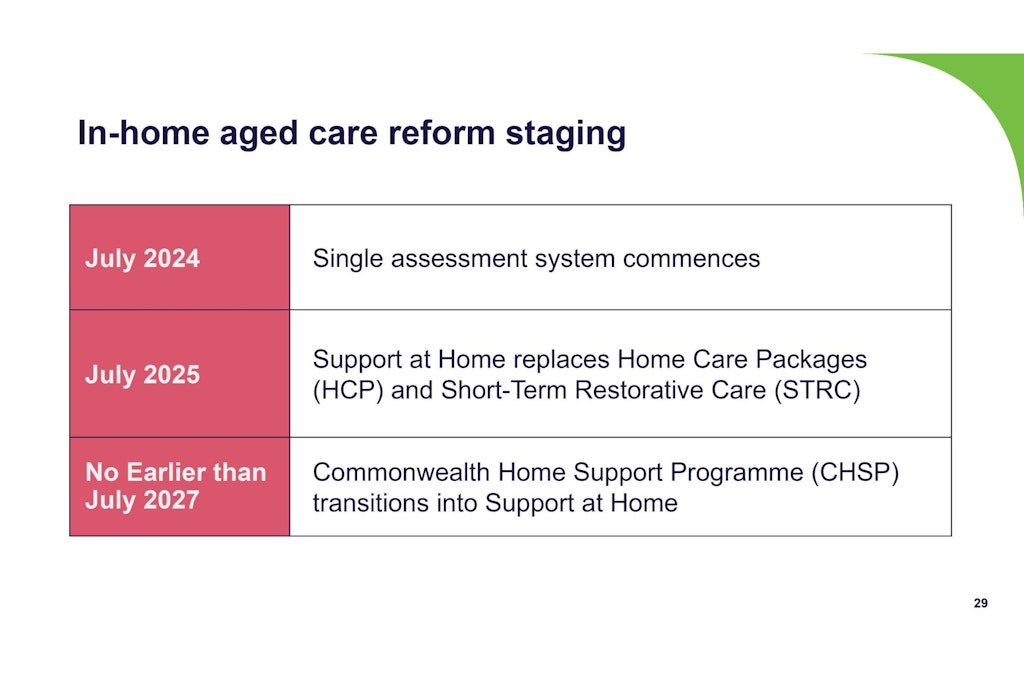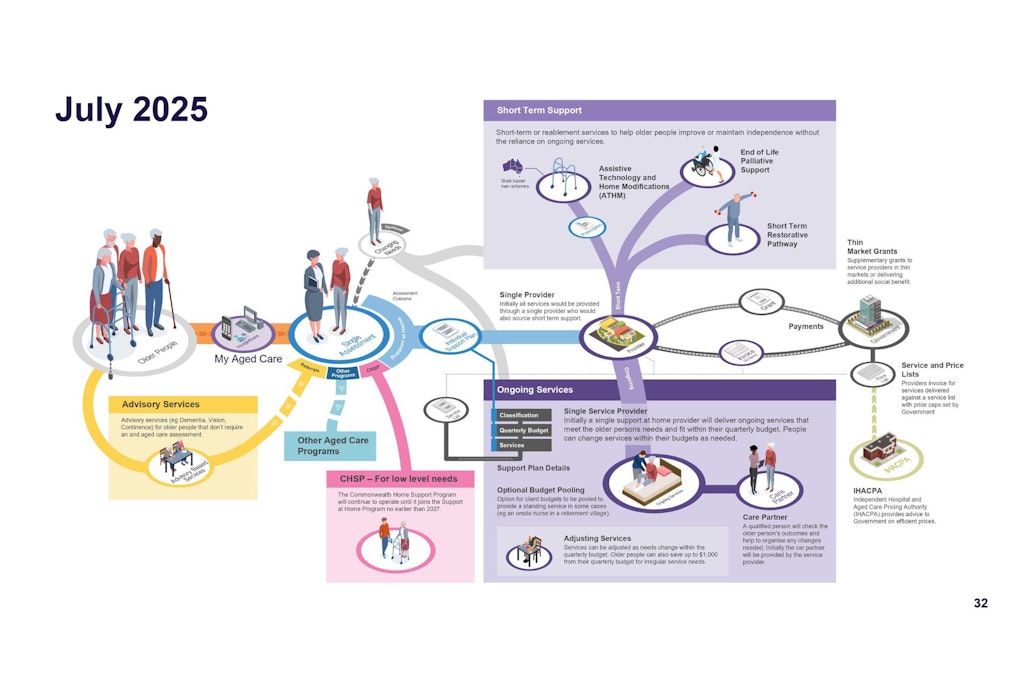Provider insight: Breaking down the in-home care reform timeline
Published on 18 December 2023 (Last updated on 22 December 2023)

Earlier in December, the Government announced the incoming Support at Home program rollout would be delayed by an additional 12 months and will be released in two stages from 2025. The Department has also provided additional information, outlining the in-home care timeline.
“While Support at Home will now be implemented in two stages the end state remains the same and that is to have a single program for in-home aged care that brings the Commonwealth Home Support Programme (CHSP), Home Care Packages (HCP) and Short-Term Restorative Care (STRC) together making it simpler for older people,” explained Nick Morgan, Assistant Secretary, Support at Home Reform Branch
These are the highlights of Mr Morgan’s presentation during a recent Government webinar.
Timeline for in-home aged care reform

Key points
- From July 2025, the new single assessment system will assess people into Support at Home classifications or CHSP
- The current home care model where an older person has a single service provider to manage and deliver all services will be retained until no earlier than July 2027
- Existing HCP clients will have a quarterly budget that aligns with their current HCP and they will continue to receive the same services
- Home care and STRC providers will transition to a new funding model with a separate assistive technology and home modification scheme
- CHSP providers and clients will continue with the existing program until at least July 2027 and grant funding will continue during this period
- New clients can enter the CHSP, and pricing will continue to be reviewed in line with indexation
The recent decision to stage the Support at Home rollout has been informed by peak body and CHSP provider feedback. With roughly 1,500 providers moving from grant to subsidy funding, staging gives them the time to adjust while HCP and STRC providers who are more readily able to switch, can do so. This additional time also benefits the Government as they introduce new ICT systems.
“With over 800,000 CHSP clients the Government felt it was critical to mitigate the risk of provider exits or failures associated with the changes. More time will also allow us to better understand and set budgets for CHSP clients,” said Mr Morgan.
“Implementation of the new assistive technology and home modification scheme will also benefit from the staging approach. We’re currently working with States and Territories on using their existing loan schemes under Support at Home and by starting with HCPs and STRC the new scheme will be smaller and more manageable.”
There is the possibility for some CHSP settings to be aligned with Support at Home ahead of the transition, including the pricing of services or higher consumer contributions if passed on by Government.
A new journey for consumers

Although the finer details of the in-home care journey are still being worked through, Mr Morgan detailed the proposed high-level approach to the consumer experience when Support at Home is introduced.
Like now, aged care consumers will enter aged care via My Aged Care or an advisory service (dementia, continence, vision) for those who do not require an aged care assessment. From there, the single assessment system will assess them for all aged care services, such as residential care, CHSP (ending in 2027), advisory services and Support At Home.
People with higher needs who want to remain at home will be assessed for Support at Home. They will receive a support plan and assessment, which in 2025 they will take to a single Support at Home provider, similar to how the Home Care Packages program operates today.
People approved for ongoing services will receive a support plan with a classification and a quarterly budget. The plan will include a list of ongoing services that can be afforded within their quarterly budget. The support plan may include approvals for short-term and/or ongoing services that would be arranged through a single provider.
There will be three types of short-term support available:
- Assistive technology and home modifications where people are approved for a funding level for assistive technology and equipment to stay in their home
- A Short-Term Restorative Pathway, similar to the existing STRC, provides allied health and multidisciplinary support for up to 12 weeks
- There is potential for an End of Life Palliative support for people diagnosed with three months or less to live and this program would be in addition to existing ongoing services to boost the home support available during this period
Additional support is available via a funded care partner who works closely with the consumer to monitor changes and care outcomes. When a person’s needs change significantly they need to be reassessed into a higher classification.
Meanwhile, the Government is exploring the possibility of multiple consumers pooling their funds and allowing them to retain unspent funds.
“If you think about a retirement village, you could imagine people pooling their funds with a provider to have a nurse on-site or a minibus service available as needed,” added Mr Morgan.
“Previously we’ve talked about client budgets that reset each quarter so that unspent funds do not accumulate. We’re now proposing that people retain savings of up to around $1,000 for unexpected expenditures if they don’t fully expend their budgets.”
When the full Support at Home program is introduced in 2027, CHSP will fold into it, and the following changes will occur:
- Short-term supports that have typically been provided through the CHSP will have a separate pathway for Limited Time Home Help
- The single-provider model will change and people can choose to have multiple service providers
- People will be able to choose a care partner who is independent of their service provider or service providers
New classifications for consumers

The Government is finalising its single assessment arrangements and tools with a trial held earlier in the year with 22,000 assessments completed. This data will inform the final classifications and funding levels for Support at Home, with 11 classifications likely (pictured above).
There are six mandatory assessment instruments in the new assessment tool covering activities of daily living, frailty, cognition, social needs and anxiety and depression. Mr Morgan said most clients had issues identified on four or more assessment scales.
The data is also going to be used in conjunction with a Deloitte study looking at whether higher budgets for in-home care would keep aged care residents at home for longer. So far, it appears it would only support a small proportion of older people.
“The study is being finalised but the initial findings suggest around 88% of people who enter residential care would not be supported safely at home with a budget equal to their residential care funding,” said Mr Morgan.
“Of the remaining 12% who could be supported safely at home, about half would still be expected to enter residential care as their preference or because their informal carers still find it too difficult to support them at home even with the additional services. That leaves around 6% of people who would otherwise enter residential care to take up a higher budget to stay at home instead.”
Further information and refinements for Support at Home will come in early to mid-2024, including additional information on proposed grant funding.